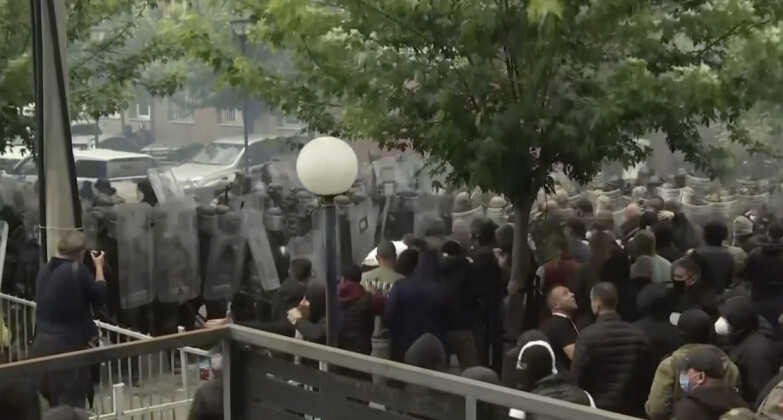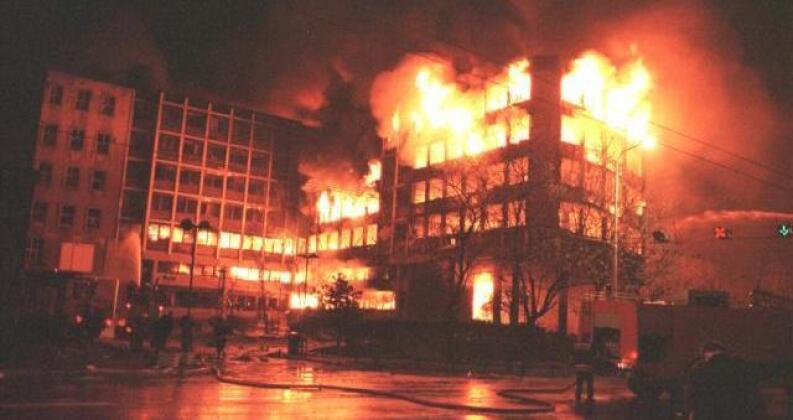Military Watch:
Clashes in Kosovo: Belgrade Warns of New War as 25 NATO Troops Injured, 50 Serb Protestors Hospitalised
May-30th-2023

Clashes with Serb Protestors on May 29
Following rising tensions between Kosovar authorities and the local Serb minority, NATO forces based on the territory clashed with Serb demonstrators in the Serb majority town of Zvecan on May 29.
Following rising tensions between Kosovar authorities and the local Serb minority, NATO forces based on the territory clashed with Serb demonstrators in the Serb majority town of Zvecan on May 29.
Serbian sources reported that Serb minority demonstrators staging a sit down protest outside municipal buildings were confronted by heavily armed members of NATO’s Kosovo Force (KFOR), who surrounded the demonstrators throwing threw stun grenades and tear gas into the crowd. This provoked retaliation with rocks, after which NATO troops escalated using batons and rubber bullets.
50 protesters were hospitalised as a result of the clashes, while 25 NATO personnel were injured. Serb citizens had launched the sit in to prevent officials from the Albanian ethnic majority from taking office, after elections had been boycotted by the Serb population as illegitimate.
Kosovo is recognised under the United Nations and by its leading non Western members states as part of Serbia, although the territory moved to secede in 2009 with Belgrade coming under intensive Western pressure to recognise its separation.
Pressure from NATO members on the country escalated further from 2022, with Belgrade pressed to support the ongoing Western war effort against Russia including through imposing economic sanctions and arming Ukraine - which it has so far refused.


Serbia Under NATO Bombardment - 1999
Ongoing tensions led Serbia to place its forces on high alert on May 26, and to move some units closer to the border with Kosovo. Serbian President Aleksandar Vucic stated on May 28 that Kosovo’s ethnic Albanian leader, Albin Kurti “longs and dreams of being a Zelensky” - in reference to the Ukrainian president and the media coverage and support he gained from the West for his country’s fight against Russia.
Ongoing tensions led Serbia to place its forces on high alert on May 26, and to move some units closer to the border with Kosovo. Serbian President Aleksandar Vucic stated on May 28 that Kosovo’s ethnic Albanian leader, Albin Kurti “longs and dreams of being a Zelensky” - in reference to the Ukrainian president and the media coverage and support he gained from the West for his country’s fight against Russia.
Serbia and NATO have a history of intensive conflict, not only after Western forces provided arms and advisors to separatist forces in Croatia and Bosnia when they separated from Yugoslavia from the early 1990s, but also when NATO commenced an intensive 78 day bombing campaign against Serbia from late March 1999.
Western forces first launched air strikes on Yugoslavia in 1995 to support attacks by U.S.-trained Croat forces, but NATO’s final assault four years later focused much more on non-military targets, with 20,000 tons of bombs dropped in 40,000 sorties - equivalent to the payload of one of the nuclear warheads dropped on Hiroshima or Nagasaki.
Extensive use of depleted uranium weapons and cluster weapons against civilian areas took a particularly heavy toll. The bombardment was initiated as part of a broad Western effort to support Kosovo’s secession to press for the withdrawal of the military from the territory, where they would be replaced by NATO forces on the ground.
Kosovo today hosts one of the U.S. Military’s largest bases in the region, Camp Bondsteel, which is expected to be among many facilities to provide support to Kosovar forces should clashes with Serbia again escalate.
Idiot, don't try to white-wash the Serbian genocide against the Bosnians, which was the key reason for the 1st NATO air bombing campaign against Serbia.
ReplyDeleteRemember Sebrenica.
Lest we Forgetm
Mfer, so u only read about the Serbian genocide against the Bosnians!
DeleteWhat about the genocide against the Serbians by the Bosnians, the Croatians, the Albanians etc after the disintegration of Yugoslavia?
Lest u forget yr own fart of selective know-nothing with lies!
Does anyone realise that the NATO’s Kosovo Force (KFOR) stationed in Kosovo IS NOT UN sanctioned?
ReplyDelete